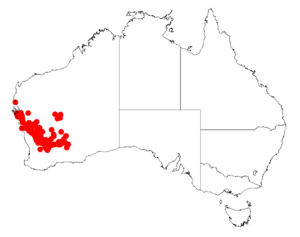Acacia longispinea facts for kids
Quick facts for kids Acacia longispinea |
|
|---|---|
| Scientific classification | |
| Genus: |
Acacia
|
| Species: |
longispinea
|
 |
|
| Occurrence data from AVH | |
Acacia longispinea is a type of shrub or small tree. It belongs to the large Acacia family, often called wattles in Australia. This plant is special because it is found only in a specific part of southwestern Australia.
Contents
About the Acacia longispinea Plant
This shrub or tree usually grows to be about 2 to 5 meters (6 to 16 feet) tall. Its branches are smooth (glabrous) and round (terete). They also have small, raised spots called lenticels, which are like tiny pores. These branches show scars where old leaf-like parts used to be.
What are Phyllodes?
Like most Acacia species, Acacia longispinea does not have true leaves. Instead, it has phyllodes. These are flattened leaf stalks that look and act like leaves. The phyllodes of Acacia longispinea are:
- Stiff and smooth
- Pointy at the end
- Always green (evergreen)
- They grow upwards or straight out
- They can be straight or slightly curved
- They have a five-sided shape when you look at them in a cross-section.
These phyllodes are usually 7 to 23 centimeters (about 3 to 9 inches) long and 1 to 2.5 millimeters wide. They have five strong, raised lines or nerves.
Flowers and Seed Pods
Acacia longispinea blooms from September to October. It produces bright yellow flowers. The flowers grow in simple, round clusters called inflorescences. Each flower cluster is about 6 to 8 millimeters (0.2 to 0.3 inches) wide. They contain 60 to 85 golden-colored flowers packed closely together.
After the flowers, smooth, papery seed pods grow. These pods hang down and are long and thin. They have bumps over each seed. The pods can be up to 7.5 centimeters (about 3 inches) long and 5 to 8 millimeters wide. Inside, the seeds are dull and mottled (meaning they have different shades). They are broad-oval to almost round and are 3 to 6 millimeters long.
How Acacia longispinea Got Its Name
The first time this plant was officially described was in 1912. A botanist named Alexander Morrison wrote about it in a science journal called The Scottish Botanical Review. A botanist is a scientist who studies plants.
Later, in 2003, another botanist named Leslie Pedley changed its name to Racosperma longispineum. However, in 2014, it was moved back to the Acacia group. Scientists believe it is closely related to another plant called Acacia gonophylla, which also has those unique five-sided phyllodes.
Where Acacia longispinea Grows
This plant is found only in certain areas of Western Australia. These areas include the Mid West, Wheatbelt, and Goldfields-Esperance regions. It usually grows on low hills and sandy plains. You can find it in gravelly, sandy, or clay soils. It is often part of shrubland communities, which are areas where many shrubs grow together.
The plant's natural home stretches from Hamelin Pool Marine Nature Reserve in the northwest. It goes down to places like Narembeen and Boorabbin in the southeast. Smaller groups of these plants can also be found further east, near Albion Downs and Comet Vale.

